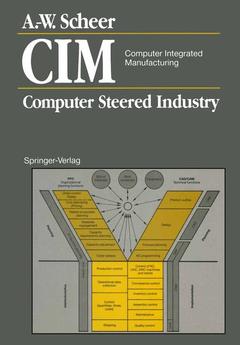Description
CIM Computer Integrated Manufacturing, Softcover reprint of the original 1st ed. 1988
Computer Steered Industry
Author: Scheer August-Wilhelm
Language: English
Keywords
Information Technology (IT); Planning; Steuerung; computer integrated manufacturing; computer-aided manufacturing; computer-integrated manufacturing; decision support system; information processing; manufacturing; networks; organization; production; production planning; production systems; scheduling
Approximative price 52.74 €
In Print (Delivery period: 15 days).
Add to cart
Publication date: 01-2012
200 p. · 17x24.4 cm · Paperback
200 p. · 17x24.4 cm · Paperback
Description
/li>Contents
/li>
Modern information technology has opened up new possibilities of flexibilization and cost reduction in production. The author defines CIM - Computer Integrated Manufacturing - as a concept for the structuring of industrial enterprises. Manufacturing technologies demand a CIM concept which can be realized through the capabilities of information processing available today. The idea of integrating different areas of CIM, such as production planning and control (PPC), computer aided design (CAD) and computer aided manufacturing (CAM), is explained through operating chains and put into a CIM architecture based on a hierarchy of EDP systems. The stance taken in this book of defining CIM as a total concept for industrial enterprises is increasingly gaining ground. The book does not aim to put the functional details of the individual CIM components (PPC, CAD, CAP and CAM) in the foreground, but rather to emphasize the integration principles for the functional demands of the individual components. This book appeared in the Federal Republic of Germany in 1987, and within one year it had run to three editions. The author contributes to this book not only his scientific knowledge but also his experience as a consultant for implementing CIM concepts.
A. The Meaning of the “I” in CIM.- I. Data and Operations Integration.- II. A Typical CIM Process Chain.- III. CIM Integration Model.- B. The Components of CIM.- I. Stage of Development of CIM Components.- a. Production Planning and Control (PPC).- 1. Primary Data Management.- 2. Planning Levels.- 3. Degree of Implementation.- 4. New Approaches to PPC Systems.- 4.1 Simultaneous Materials and Capacity Management.- 4.2 Load Oriented Order Release.- 4.3 KANBAN.- 4.4 Running Total Concept.- 4.5 MRP2.- 4.6 Decentralization.- b. Computer Aided Design (CAD).- 1. Tasks.- 2. Geometric Models.- 3. CAD Standard Interfaces.- 4. Interactive Control.- c. Computer Aided Planning (CAP).- 1. Work Scheduling for Conventional Processing.- 2. Work Scheduling for NC Machines.- d. Computer Aided Manufacturing (CAM).- 1. Automated Production.- 1.1 Machine Tools.- 1.2 Robots.- 1.3 Storage Systems.- 1.4 Conveyance Systems.- 2. Computerized Organizational Forms for Flexible Production.- 2.1 Processing Centers.- 2.2 Flexible Production Cells.- 2.3 Flexible Production Systems.- 2.4 Production and Assembly Islands.- 2.5 Flexible Transfer Lines.- e. Computer Aided Quality Assurance (CAQ).- f. Maintenance.- II. Interfaces Between CIM Components.- a. Data Relationships Between CAD and CAM.- b. Data Relationships Between PPC and CAD/CAM.- 1. Data Flow from CAD/CAM to PPC.- 1.1 Primary Data.- 1.2 Customer Order Data.- 1.3 Production Order Data.- 2. Data Flow from PPC to CAD/CAM.- 2.1 Primary Data.- 2.2 Customer Order Data.- 2.3 Production Order Data.- C. Implementation of CIM.- I. Methods of Developing a CIM Strategy.- II. Definition of a CIM Hierarchy.- a. Functional and Computer Hierarchy.- b. Functions of a CIM Level.- III. Manufacturers and Advisors.- IV. Implementation Steps.- a. CIM Sub-chains.- 1. Sub-chain: Linking of Planning and Control.- 2. Sub-chain: Linking of CAD and CAM.- 3. Sub-chain: Linking of Primary Data Management.- 4. Sub-chain: Linking of Data Collection and CAM.- b. Assessment of Sub-chains on the Basis of Production Types and Strategic Implications.- V. Integration Tools.- a. Organizational Solution.- b. Use of Tools.- 1. Microcomputers.- 2. Database Query.- 3. Local Area Networks (LAN).- 3.1 The Aims of MAP.- 3.2 MAP Functions.- 3.3 Embedding of MAP in General Network Architectures.- c. Common Databases.- 1. Data Exchange.- 2. Unified Databases.- 3. CIM Data Handlers.- d. Inter-Application Communication.- D. CIM Prototypes.- I. Solutions not in Productive Use.- a. CIM Center Munich (IBM).- b. CAI Concept (Siemens).- c. PROCIM (IWi).- d. DEC Prototype.- e. CIM Technology Center (Nixdorf).- II. User Solutions.- a. Computerized Flexible Production Chains for Pressed Sheet Metal Parts at MBB (Bremen).- b. Information and Control System in the Production Area as a Central Agency for the Dataflow of a CIM Concept at BMW AG (Dingolfing).- c. Order Handling with CIM.- E. Further CIM Developments.- I. Design Stage Cost Estimation.- a. Design as the Decision Center for Production Costs.- 1. Cost Related Decision Alternatives in Design for a Conventional Breakdown Between Design and Process Planning.- 2. Cost Related Decision Alternatives in Design for Organizationally Integrated Design and Process Planning.- b. Cost Estimation Techniques for the Design Phase.- 1. Overview.- 2. Cost Estimation Procedures.- 2.1 Flat Rate Cost Estimation Procedures.- 2.2 Cost Estimation Based on Characteristic Values.- 2.3 Cost Estimation Based on Similarities.- 2.4 Analytical Estimation Methods.- 2.5 Estimation on the Basis of Geometry Data.- 2.6 Cost Estimation from Primary Production Data.- II. Decision Support Systems in CIM.- III. Inter-Company Process Chains in CIM.- a. PPC Integration.- 1. Initial Position.- 2. Data Exchange.- 3. Application Integration.- 4. General Effects.- b. CAD/CAM Integration.- 1. Initial Position.- 2. Data Exchange.- 3. Application Integration.- 4. General Effects.- F. References.- G. Index.
© 2024 LAVOISIER S.A.S.




